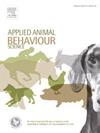Assessing the impact of a human behaviour change intervention to reduce owner-related barriers to interactive cat play
IF 2.2
2区 农林科学
Q1 AGRICULTURE, DAIRY & ANIMAL SCIENCE
引用次数: 0
Abstract
Although cats are popular pets and often viewed as family members, many cat owners fail to meet their welfare needs. This failure may occur due to several factors, including a lack of awareness and education, a lack of time or interest, and not prioritising the welfare needs of a companion animal due to competing motivations. This study expands on previous research that identified common barriers to owners engaging in daily wand toy play with their pet cat. The Behaviour Change Wheel framework, including the COM-B model, were used to design an educational digital campaign to encourage cat owners to play with their cats daily by removing or reducing several of the identified barriers (COM relates to the three categories of barriers - Capability, Opportunity and Motivation which influence B – the target behaviour). Pre and post-intervention surveys were conducted before and after the campaign. Three hundred and sixty-three cat owners completed the matched surveys. Participants reported positive impacts within the survey, with 35.3 % reporting that they played with their cats more regularly with a wand toy because of the campaign. An additional 11.9 % intended to change how often they play this way with their cats. After the campaign, participants reported fewer Capability barriers (S = −2442, p < 0.0001) and fewer Motivational barriers (S = −2532, p < 0.0001) to interactive play. Participants also reported fewer behaviour problems in their cats after the campaign. Most participants found the campaign materials enjoyable. This study demonstrates the positive impact of a short, digital campaign to increase self-reported play behaviour of cat owners with their pets.
求助全文
约1分钟内获得全文
求助全文
来源期刊

Applied Animal Behaviour Science
农林科学-行为科学
CiteScore
4.40
自引率
21.70%
发文量
191
审稿时长
18.1 weeks
期刊介绍:
This journal publishes relevant information on the behaviour of domesticated and utilized animals.
Topics covered include:
-Behaviour of farm, zoo and laboratory animals in relation to animal management and welfare
-Behaviour of companion animals in relation to behavioural problems, for example, in relation to the training of dogs for different purposes, in relation to behavioural problems
-Studies of the behaviour of wild animals when these studies are relevant from an applied perspective, for example in relation to wildlife management, pest management or nature conservation
-Methodological studies within relevant fields
The principal subjects are farm, companion and laboratory animals, including, of course, poultry. The journal also deals with the following animal subjects:
-Those involved in any farming system, e.g. deer, rabbits and fur-bearing animals
-Those in ANY form of confinement, e.g. zoos, safari parks and other forms of display
-Feral animals, and any animal species which impinge on farming operations, e.g. as causes of loss or damage
-Species used for hunting, recreation etc. may also be considered as acceptable subjects in some instances
-Laboratory animals, if the material relates to their behavioural requirements
 求助内容:
求助内容: 应助结果提醒方式:
应助结果提醒方式:


